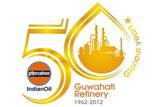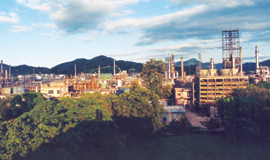Guwahati Refinery (Assam)
 Guwahati Refinery is the country's first Public Sector Refinery as well as IndianOil's first Refinery serving the nation since 1962. Built with Rumanian assistance, the initial crude processing capacity at the time of commissioning of this Refinery was 0.75 MMTPA and the Refinery was designed to process indigenous Assam Crude. The refining capacity was subsequently enhanced to 1.0 MMTPA. Due to dwindling supply of indigenous Assam Crude, Guwahati Refinery started processing Low Sulfur Imported Crude along with Assam Crude. The supply of LS imported crude to Guwahati Refinery is from Barauni Refinery via railway wagons.
Guwahati Refinery is the country's first Public Sector Refinery as well as IndianOil's first Refinery serving the nation since 1962. Built with Rumanian assistance, the initial crude processing capacity at the time of commissioning of this Refinery was 0.75 MMTPA and the Refinery was designed to process indigenous Assam Crude. The refining capacity was subsequently enhanced to 1.0 MMTPA. Due to dwindling supply of indigenous Assam Crude, Guwahati Refinery started processing Low Sulfur Imported Crude along with Assam Crude. The supply of LS imported crude to Guwahati Refinery is from Barauni Refinery via railway wagons.
The Refinery supplies various petroleum products to Northeastern India as well as beyond, upto Siliguri end through the Guwahati-Siliguri Pipeline, spanning 435 KM, which was the first Pipeline of IndianOil and commissioned in 1964. Most of the products of Guwahati Refinery are evacuated through pipeline and some quantity also through road transportation.
LPG, Naphtha, Motor Spirit (MS), Aviation Turbine Fuel, Superior Kerosene Oil, High Speed Diesel (HSD), Raw Petroleum Coke and Sulfur are the products of this Refinery. Auto fuels MS and HSD supplied by the refinery are of eco-friendly BS-IV grade as per statutory guidelines of Government of India. The production of these valuable petroleum products is through a series of different primary and secondary processing units along with the associated auxiliary facilities like Captive Power Plant installed within the refinery.
In the primary unit of the Refinery i.e. the Crude Distillation Unit (CDU), desalted crude from the desalter is heated up through a series of heat exchangers and is fed into a pre fractionator column. Here the lighter gases, LPG and unstabilised gasoline are separated. The outputs from CDU are gasoline, Kero-I, Kero-II and Straight Run Gas Oil. Reduced Coke Oil (RCO) which is the bottom product from the main fractionating column, forms the main raw material for Coking unit and Indmax. In the Naphtha Splitter section, total Straight Run Naphtha is separated into three different fractions namely Light Naphtha (LN), Reformate Naptha (RN) and Heavy Naptha (HN).
 Delayed Coking Unit (DCU) with a capacity of 0.44 MMTPA is the main secondary unit of Guwahati Refinery. The unit produces middle distillates from heavy ends. Main feedstock to DCU is Reduced Crude Oil, which is heated to high temperature of about 500oC in a furnace. Due to high temperature, RCO is thermallycracked and yields various hydrocarbon fractions like LPG, coker gasoline, coker kerosene, coker gas oil, coker fuel oil, residual fuel oil and coke.
Delayed Coking Unit (DCU) with a capacity of 0.44 MMTPA is the main secondary unit of Guwahati Refinery. The unit produces middle distillates from heavy ends. Main feedstock to DCU is Reduced Crude Oil, which is heated to high temperature of about 500oC in a furnace. Due to high temperature, RCO is thermallycracked and yields various hydrocarbon fractions like LPG, coker gasoline, coker kerosene, coker gas oil, coker fuel oil, residual fuel oil and coke.
INDMAX Unit, in-house technology developed by R&D Centre of IndianOil was installed for increased production of LPG and gasoline from heavy ends like Reduced Crude Oil and Coker Fuel Oil. Indmax unit works on the Fluidized Catalytic Cracking process similar to other Fluidised Catalytic Cracking Units. The first commercial unit based on INDMAX technology was installed at Guwahati Refinery with a capacity of 0.1 MMTPA, and the capacity was subsequently enhanced to 0.15 MMTPA. Besides its function of maximization of LPG, it enables the Refinery to upgrade its residual products to high value distillate products.
Hydrotreating Unit with a capacity of 0.6 MMTPA produces High Speed Diesel (HSD), Aviation Turbine Fuel (ATF) and Pipeline Compliant Kerosene (PCK) in blocked out mode of operation. In HSD mode of operation, Sulfur content of diesel components ex CDU, DCU and Indmax unit is removed and Cetane number is boosted. Smoke point of Straight Run Kerosene component is improved in ATF and PCK modes along with desulfurization. Hydrogen required for Hydrotreating is produced in Hydrogen Generation Unit based on Steam Reforming technology.
Isomerization unit (45 TMTPA) produces MS component by improving Research Octane Number upto 87.0 units and also helps in meeting the Benzene content specification of MS.
INDA DEPT unit (35 TMTPA , developed by IOCL-R&D and EIL, removes Sulfur content from Heavy Cut of Indmax gasoline to < 50 ppm to meet the Sulfur specification of BS-VI quality MS.
The Sulphur Recovery Unit (5 TPD) in the Refinery takes care of the sour off gases from the various units for removal of Hydrogen Sulphide. This is done by Amine treatment after which H2S is converted to sulphur through the Clause process.
Guwahati Refinery is amongst those Indian Refineries who have standardized their various systems and has been awarded with ISO-9001 for Quality Management, ISO-14001 for Environment management, OHSAS-18001 for Occupational Health and Safety and ISO-27001 for Information Security management. Guwahati Refinery has also been certified with the ISO-50001 certification in recognition of its sincere efforts to manage its energy usage in an efficient manner. Guwahati Refinery is also known for its sincere efforts on development as well as implementation of effective Safety, Health & Environment management systems and procedures along with good performance in occupational health and safety.
In Reliability Improvement, the replacement of switchgears, upgradation of Distribted Control System (DCS), Programmable Logic Controller (PLC) for turbines TG 3 & 4 and upgradation of Load Shedding System have brought about remarkable positive changes.
"Prakriti Ke Saath - Pragati Ki O’r explains the Refinery's commitment to environment. The Modernized Effluent Treatment Plant commissioned in March'07, the online analyzers SOx NOx ,CO,PM with connectivity to CPCB server for continuous stack emission monitoring are watchdogs of Refinery emissions.
Guwahati Refinery is committed in its responsibility towards the community around it and the larger society. It is also deeply committed to safeguarding and preserving ecological balance. It has been taking proactive measures continuously for the improvement of safety, health and environment standards due to progressive proximity of community settlements around the Refinery. The measures include tree plantations, improvement in drainage systems, house-keeping and cleanliness drives as well as substantive programmes adopted on successive World Environment Days to enhance awareness of the individual and collective responsibilities towards environment preservation among the employees and their families, students and the community in general.
The Refinery's concerns for environment protection is further demonstrated by extensive tree plantation and development of Ecological Park and Sanjeevani Udayan in and around the Refinery further spearhead its efforts to the cause of ecological balance. Planting and preserving bio-diversified species are continual efforts in preserving bountiful nature. Periodic campaigns are also carried out in the neighborhood to bring home the importance of a clean environment.
Emergency planning and response is ensured through well laid out Onsite and Offsite Disaster Management plans and periodic drills on simulated scenario. All credible scenarios like Fire and Vapor Cloud Explosion, Oil Spill, Hydrocarbon release, Toxic gas release, flood, and earthquake and security threats are incorporated in the Disaster Management Plans.
To keep air pollution in check, Guwahati Refinery has installed one Continuous Ambient Air Quality Monitoring Station (AAQMS), with connectivity to CPCB server which continuously monitors ambient air quality.
A number of efficient mechanisms for water pollution prevention and control are in place in the Refinery. It has modified the API Separator by which there will be further improvement of oil separation efficiency. A Electro chlorinator that is used to combat slime and algae formation installed to provide continuous treated effluent chlorinated water .On-line analyzers (pH,COD,BOD,TSS) are installed at Effluent Treatment Plant with connectivity to CPCB server for continuous monitoring of treated effluent quality .
An effluent treatment plant with continuous system improvement by addition of Dual Media Filters, Dissolved Air Flotation (DAF),Floating Drum Skimmer ,full-fledged pollution control laboratory and reuse of treated effluent in the Refinery ensures the adherence to applicable standards.
The Refinery has taken up initiatives for solid waste management with processing of Accumulated Sludge through oil recovery Bio-remediation of Residual Sludge, processing of sludge in DCU. Moreover, the Refinery has installed solar PV system in Canteen, solar panels at roof tops of the various location of the refinery ,replaced general lighting with LED, processed food waste generated from canteen and refinery township ,waste paper processing under sustainability development.
The occupational health centre of Guwahati Refinery Hospital, since its inception in 1994, has been providing comprehensive services to the corporation's employees, their dependents and to the community. Periodical medical examination, Hearing Conservation Programme, Pulmonary Function Test, Training and Awareness Programmes etc,. are a few of the activities which had been undertaken in the recent past.
Total Productive Maintenance has been a way of life for refiners at Guwahati in the plant, at the offices since October 2004, with improved work culture and employees ownership. The Refinery has recently qualified for the TPM Excellence Award (Final Assessment) and is soon set for the TPM Sustenance Award certification.
Enhancing skill development and knowledge management with in-house and outside training are inbuilt HRD initiatives. Innovation and Creativity are recognized at all levels. Guwahati Refinery is proud of it's continued good performance and recipient of prestigious corporate level awards.
Catering to the work life balance of its employees, the Refinery provides infrastructure facilities for pursuing a variety of sports, games and cultural interests for all employees and their dependents.
In tune with IndianOil's commitment as a responsible stakeholder, Guwahati Refinery implements various developmental initiatives under it CSR interventions for benefiting the local community, especially in thrust areas like skill-development & education, empowerment of women, healthcare & sanitation, safe drinking water, among others.
Business improvement in a globalized, liberalized and competitive market is the result of highly effective and committed leadership. Regular communication and open sessions with Chairman, Directors, ED and top management, enable achieving business results. Joint Management Council meetings through participative management are held regularly and information sharing through the net and publications ensure alignment of goals and actions at every level.

